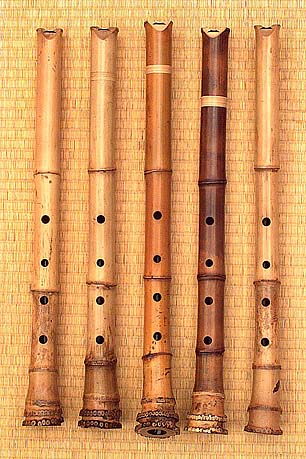|
|
|
|

The quality of a shakuhachi is determined by two factors.
Aesthetics of the bamboo as distinguished by its age, size,
color, shape, nodal placement, and root configuration. Performance
of the instrument is reflected in its tonal quality, balance
of notes, and resonance responsiveness. ai Hei Shakuhachi are
carefully evaluated, graded and priced with all of these factors
in mind.
In evaluating a shakuhachi the following criteria are considered: bamboo aesthetics and craftsmanship along with performance and acoustical issues. The latter considerations take into account intonation (tuning for pitch), timbre (tone color), and the resonance response of all the open-hole tones.
Intonation is a simple determination of whether the instrument is in tune or not with standard Western pitch at room temperature. If not, which notes are sharp or flat and what can be done to correct the problems. Generally, pitch is determined by the relative diameter, chimney height (depth), and position of the finger holes, but can be affected by resonance issues as well. It is important to remember that the temperature of a room in which an instrument is played is a significant factor in measuring intonation as the speed of sound in air is directly proportional to ambient temperature. The standard for most musical instruments tuned to Equal Temperament is A=440 or 442 hz. at 20° C / 68°F).
Timbre or tone color (neiro, in Japanese) is largely determined by the overall design of the bore and essentially a matter of personal taste. Timbre translates into harmonic configuration or the spectrum of frequencies that make up each individual tone. Not much can be done to alter this aspect of the a flute without completely redesigning and rebuilding the bore. Each traditional maker tends to have a recognizable quality of sound in this regard.
Resonance is by far the most important issue in assessing the acoustical and performance qualities of a shakuhachi. It is the domain in which most wind instruments are likely to exhibit problems, but fortunately one that is correctable.
Resonance response governs how much air the flute will accept and how hard it can be challenged or pushed without acoustical consequences that diminish its sound production. If blowing across the utaguchi produces vibrations that match the natural frequencies of standing waves inherent in the profile of the oscillating air column inside a shakuhachi, then the transfer of energy is optimized. That is to say, little energy is wasted and lost in the transformation of breath to sound, thus is highly efficient. A well-designed shakuhachi bore, fabricated within a tolerance of plus or minus 0.01 mm., has the potential to produce a strong, robust, or "big" sound with minimal vibrational input for all the open-hole frequencies. More simply put, the flute will respond by producing deep, rich tones having a wide dynamic range within a large envelope of sound if the vibrational modes initiated at the mouthpiece match the natural frequency of the instrument's precision bore profile.
Any shakuhachi, including the most primitive plastic plumbing pipe models, will perform adequately if the player blows softly, thereby exercising only the fundamental frequency in the harmonic series of sound. As more air is introduced into the bore and blowing intensifies, a composite of higher partials called “overtones" are simultaneously exercised giving the shakuhachi its distinctive full-bodied and resonant ringing tone. If the bore profile of an instrument is not properly fabricated and rendered to a very precise shape, acoustical problems will result. Unwanted vibrato, notes jumping into higher octaves, instability and weakness of tone, and, in extreme case, the inability to produce a clear sound at all are just a few manifestations of resonance problems. This aspect of assessing and grading the quality of a shakuhachi represents the greatest challenge to traditional makers.
Tai Hei Shakuhachi are distinctive,
high-quality instruments. Student-grade flutes are superior in
all respects to wooden mass-produced instruments and are preferred
by many traditional teachers for their beginning and intermediate
students. Professional root-end shakuhachi provide an affordable
alternative to imported Japanese flutes to which they compare
favorably in terms of performance, appearance, durability and
cost. These instruments are being used by teachers and professional
musicians in Japan and throughout the world.